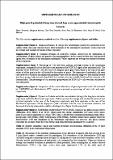Por favor, use este identificador para citar o enlazar a este item:
http://hdl.handle.net/10261/181716COMPARTIR / EXPORTAR:
 SHARE SHARE
 CORE
BASE CORE
BASE
|
|
| Visualizar otros formatos: MARC | Dublin Core | RDF | ORE | MODS | METS | DIDL | DATACITE | |

| Título: | High Growth Potential of Long-Term Starved Deep Ocean Opportunistic Heterotrophic Bacteria |
Autor: | Sebastián, Marta CSIC ORCID; Estrany, Margarita; Ruiz-González, Clara CSIC ORCID ; Forn, Irene CSIC ORCID ; Sala, M. Montserrat CSIC ORCID ; Gasol, Josep M. CSIC ORCID ; Marrasé, Cèlia CSIC ORCID | Palabras clave: | Bacteria Deep ocean Bathypelagic Prokaryotes Microbial seed bank Long-term starvation |
Fecha de publicación: | abr-2019 | Editor: | Frontiers Media | Citación: | Frontiers in Microbiology 10: 760 (2019) | Resumen: | Experiments with bacteria in culture have shown that they often display “feast and famine” strategies that allow them to respond with fast growth upon pulses in resource availability, and enter a growth-arrest state when resources are limiting. Although feast responses have been observed in natural communities upon enrichment, it is unknown whether this blooming ability is maintained after long periods of starvation, particularly in systems that are energy limited like the bathypelagic ocean. Here we combined bulk and single-cell activity measurements with 16S rRNA gene amplicon sequencing to explore the response of a bathypelagic community, that had been starved for 1.6 years, to a sudden organic carbon supply. We observed a dramatic change in activity within 30 h, with leucine incorporation rates increasing over two orders of magnitude and the number of translationally active cells (mostly Gammaproteobacteria) increasing 4-fold. The feast response was driven by a single operational taxonomic unit (OTU) affiliated with the Marinobacter genus, which had remained rare during 7 months of starvation. Our work suggests that bathypelagic communities harbor a seed bank of highly persistent and resourceful “feast and famine” strategists that might disproportionally contribute to carbon fluxes through fast responses to occasional pulses of organic matter | Descripción: | 12 pages, 6 figures, supplemental material https://www.frontiersin.org/articles/10.3389/fmicb.2019.00760/full#supplementary-material | Versión del editor: | https://doi.org/10.3389/fmicb.2019.00760 | URI: | http://hdl.handle.net/10261/181716 | DOI: | 10.3389/fmicb.2019.00760 | Identificadores: | doi: 10.3389/fmicb.2019.00760 e-issn: 1664-302X |
| Aparece en las colecciones: | (ICM) Artículos |
Ficheros en este ítem:
| Fichero | Descripción | Tamaño | Formato | |
|---|---|---|---|---|
| Sebastian_et_al_2019.pdf | 552,43 kB | Adobe PDF |  Visualizar/Abrir | |
| Sebastian_et_al_2019_suppl_1.PDF | 702,12 kB | Adobe PDF |  Visualizar/Abrir | |
| Sebastian_et_al_2019_suppl_2.xlsx | 26,02 kB | Microsoft Excel XML | Visualizar/Abrir |
CORE Recommender
PubMed Central
Citations
17
checked on 14-abr-2024
SCOPUSTM
Citations
27
checked on 11-abr-2024
WEB OF SCIENCETM
Citations
27
checked on 27-feb-2024
Page view(s)
331
checked on 16-abr-2024
Download(s)
335
checked on 16-abr-2024

